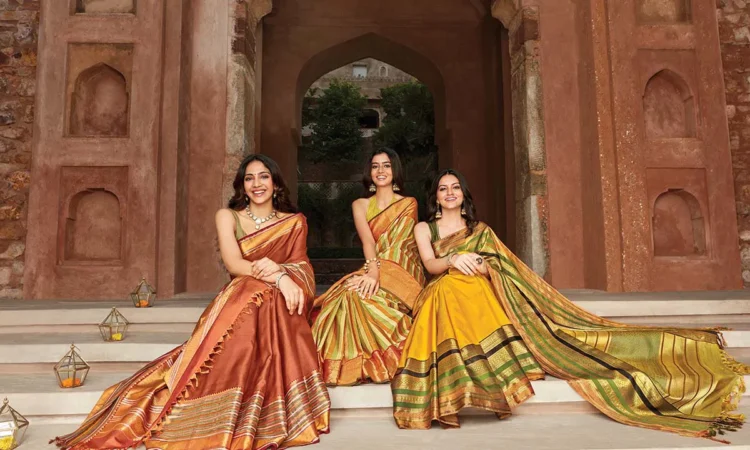
As Diwali approaches, homes across India glow with the soft shimmer of diyas, the sky sparkles with fireworks, and the air hums with excitement. But beyond the lights, sweets, and rituals, there’s another Diwali tradition that quietly upholds our cultural heritage: the saree. This exquisite garment, with its endless possibilities for draping, weaving, and styling, is a cherished part of the Diwali celebration, connecting us to the heart of India’s rich textile history. From ancient rituals to modern-day festivities, the saree has stood as a testament to tradition, elegance, and innovation.
A Symbol of Tradition and Prosperity
In the days leading up to Diwali, you’ll find women browsing through stacks of sarees, each more exquisite than the last. There’s an excitement in the air, a sense of anticipation. For many, wearing a saree during Diwali is more than just a sartorial choice—it’s a tradition. Sarees have long been associated with prosperity and grace, making them a natural choice for this auspicious festival that celebrates the triumph of light over darkness.
Historically, sarees were often gifted during Diwali as a symbol of goodwill and fortune. In some families, this practice has continued for generations, with heirloom sarees passed down as precious treasures. Imagine the golden threads of a centuries-old Banarasi silk saree gleaming under the soft glow of Diwali lamps—each thread a testament to the artistry of its weavers, each fold carrying with it the stories of the women who have worn it before. Such festive sarees become keepsakes, linking the past to the present and preserving the cultural fabric of families.
Sacred Rituals and the Saree
The saree also plays a significant role in Diwali rituals, particularly during the Lakshmi Puja, when many women choose auspicious colours such as gold, red, or yellow. These colours are seen as symbols of prosperity, fertility, and devotion, invoking the blessings of Goddess Lakshmi, the deity of wealth and abundance. The Diwali saree, with its rich cultural symbolism, becomes part of the puja, offering not just beauty but reverence and spirituality.
In some parts of India, sarees are used to adorn deities during temple ceremonies, further underscoring their sacred status. For instance, in South India, idols of deities are draped in exquisite Kanjivaram sarees, transforming the garment from festive attire to a sacred offering. This tradition highlights the saree’s deep-rooted connection to spirituality and the divine, reflecting its importance in both the religious and cultural fabric of Diwali.
The Evolution of Sarees in Contemporary Diwali
While the saree remains a cornerstone of Diwali traditions, the way it is worn today has evolved. Modern women are redefining how festive sarees are styled. Gone are the days when the saree was viewed as cumbersome or outdated. Today, it is embraced as a versatile, elegant option that can easily blend with contemporary fashion trends.
One of the most popular modern adaptations is the rise of pre-draped sarees, offering the traditional look without the complexity of managing pleats. During the fast-paced Diwali festivities, when there is little time for elaborate draping, these pre-stitched sarees offer a practical yet stylish alternative. Young women are experimenting with different draping styles—like saree gowns or dhoti-style drapes—creating new silhouettes that honour tradition while reflecting individual style.
Celebrating the Diversity of Sarees Across India
One of the most remarkable aspects of the Diwali saree is its diversity. Across India, each region boasts its own unique style of saree, crafted using local materials and techniques that reflect the region’s cultural heritage. During Diwali, this diversity comes alive, as women choose sarees that represent not only their personal style but also their regional identity. In the east, Bengal’s Baluchari sarees are adorned with intricate mythological motifs, while in the north, Banarasi silk sarees with their luxurious brocade work remain a favourite. The south offers the grandeur of Kanjivaram sarees, known for their vibrant colours and rich silk, while the west celebrates the vibrant tie-dye Bandhani and Patola sarees of Gujarat.
The Timeless Appeal of Diwali Sarees
Diwali is a time for celebration, reflection, and connection with loved ones, and the saree plays a crucial role in these festivities. Whether it’s the traditional silks worn during religious ceremonies, or the modern, innovative styles embraced by younger generations, the Diwali saree remains a symbol of grace, continuity, and cultural pride.
As Diwali lights up homes and hearts across India, the saree weaves together the threads of the past and present, connecting generations through the simple act of wearing a garment. This Diwali, as you drape yourself in a beautiful festive saree, consider the stories it carries, the traditions it upholds, and the timeless beauty it represents—both as a piece of clothing and as a cherished symbol of India’s rich cultural heritage.




